Shooting Star Hill is a freeware doujin Japanese visual novel created by Mr. Azuki Taka. It was released in Japan on January 16, 2005, under the name 星の降る丘 (“Hoshi no Furu Oka”). With the consent of the creator, Hoshi no Furu Oka was officially translated into English by Mr. Anthony Low (“Kawatori Shinji”) and submitted to the al|together 2006 visual novel translation festival under the English name Shooting Star Hill (released in English on August 20, 2006). I am in the midst of a project to review nearly all of the 30-plus visual novels that were submitted to the three al|together festivals in 2005, 2006, and 2008 (see series introduction and list of completed reviews). Today I cover Shooting Star Hill as my fourth review of the series.

Shooting Star Hill is a short visual novel that covers the budding relationship of a boy who just transferred into a new high school and a lonely girl who happens to be in his new class. The boy took an interest in the girl after he noticed her seeing the same (fictional) British science fiction film that he was present at – aptly called The Miracle of Starhilll.
In this post, I will review Shooting Star Hill without spoiling the key events of the story. If you decide to play Shooting Star Hill, which should take close to one hour, I wrote a separate analysis of the story and its themes which discusses the plot in detail.
Updates (11.27.22)
I made some substantial revisions to this review on November 27, 2022. My main purpose in the revisions was to improve the format and structure of this review with innovations I introduced in later al|together reviews. In so doing, I updated the section on downloading and running Shooting Star Hill and improved several other sections, including my research into whether Shooting Star Hill is a finished work. Finally, my original conclusion came off as less positive than I had intended, so I re-wrote parts to better express my sentiments about what is one of the best visual novels to come out of the al|together festivals.
I may at some point in the future replace the screenshots in this article with versions that do not have window borders.
Shooting Star Hill Details
English release
| Title | Shooting Star Hill |
| Translator | Anthony Low (“Kawatori Shinji”) |
| Release | August 20, 2006 |
| Engine | ONScripter-EN |
| Visual Novel Databse | VNDB Link |
Japanese release
| Title | Hoshi no Furu Oka |
| Creator | Ebi Shumai II |
| Website | Original, Archived |
| Release | January 16, 2005 |
| Engine | NScripter |
Downloading and Running Shooting Star Hill
Shooting Star Hill remains available for free download from the al|together 2006 website.
- Official download (direct and torrent): Windows, MacOS, and Linux
- Kaisernet mirror (direct): Windows
I use Linux on all of my computers. My review was based on the Windows version of Shooting Star Hill running on top of WINE, which worked with no issue
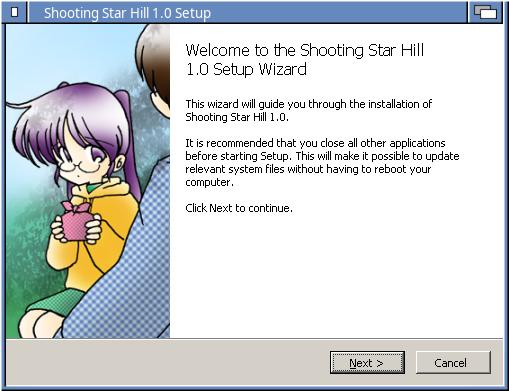
When I first wrote my review, I could not figure out how to run the Linux version of Shooting Star Hill because the ONScripter executeable that it comes with did not work (segmentation fault). I subsequently learned how to run the Linux version. I explained methods involving installing ONScripter-EN on one’s system and running a new version of ONScripter-EN within a single directory. You may also be interested in my guide on extracting the contents of the Windows .exe to run locally on Linux, MacOS, and BSD.
I had no issues with Shooting Star Hill running through WINE or natively on Linux.
Is Shooting Star Hill a Trial Or a Complete Game?
The title card for Shooting Star Hill describes it as “Visual Novel volume 1.” In the game’s Readme (you will find it in the files for Shooting Star Hill if you download it), the translator explained:
This is the first work of the circle Ebishuumai II. This game was released as freeware after some adjustments were applied to the original. Since January 2005, this group has produced three games. Hopefully you may find some meaning in Ebishuumai II’s work even though this is a trial version. The other game, Rakuen Kanenone to Tomo, has a trial version too. Although it is a trial version, you are able to play through to the ending. Hopefully you can have fun.
This is a bit confusing. Thus, I decided to address the issue before launching into my review.
Shooting Star Hill reads like a finished product. It has a proper conclusion and ending credits. I will go so far as to say that given its ending, it would seem to be an unlikely candidate for a sequel.
The translator wrote:
Although it is a trial version, you are able to play through to the ending.
That one can play to the ending is true. I am not sure how the term trial was being used here. Moreover, my understanding Shooting Star Hill as a completed game is consistent with its Visual Novel Database page, which does not indicate that it is a trial or part of a series.
However, after considering the translator’s explanation and looking at the other works of Ebi Shumai II, I think that I understand how Shooting Star Hill was a “trial.”
The Readme noted that Shooting Star Hill, like Rauken wa Kanenone to Tomoni, another work by Ebi Shumai II, was a trial. The Visual Novel Database only lists three works by Ebi Shuumai – with Shooting Star Hill being the first and Rakuen wa Kanenone to Tomoni being the second. Of the three, Shooting Star Hill is the only one to have been translated. There is no indication that Shooting Star Hill is directly related to Rakuen wa Kanenone to Tomoni or the third Ebi Shumai II game, Aoi Tsukiyo no Onigokko, but it is possible that the three games were intended to be a three volume set.
A close look at the Visual Novel Database reveals something interesting about Rakuen. Its release date is listed as March 14, 2012. Conversely, the original Japanese Shooting Star Hill was released in 2005. The third Ebi Shumai II game was, like Rakuen, released in 2012. Yet the Shooting Star Hill Readme states that a trial version of Rakuen was available in 2005.
While I cannot say for sure, it seems possible, if not likely, that Ebi Shumai II had intended to release a final version of Shooting Star Hill, but never did so. Conversely, the latter two games received final versions after their trial releases.
(If any readers happen to know more of the story, I invite you to email me so I can improve this section.)
While the issue is interesting, it ultimately matters little for our purposes. Shooting Star Hill has a complete story with a beginning, middle, and end. Moreover, even if it was intended to be a first version of the game rather than a finished product, it is one of the more visually polished games in the al|together collection.
General Overview of Shooting Star Hill
The al|together 2006 festival page for Shooting Star Hill described the visual novel as follows:
There’s one at every school – the quiet, aloof girl that nobody really wants to get to know. But this one catches Chihiro’s eye when he discovers she’s a fan of the cult British science fiction films he loves… and that really leaves him with very few options.
The player takes the role of Chihiro Naruse, a high school student who moved due to his father’s work and is beginning his life at a new school. On his first day in town, he goes to see a British science fiction film called Shooting Star Hill. There, a girl about his age who is also seeing the movie catches his attention – especially when she leaves with tears in her eyes. The next day, to his surprise, he finds that the girl, Kana Moriyama, is his classmate.
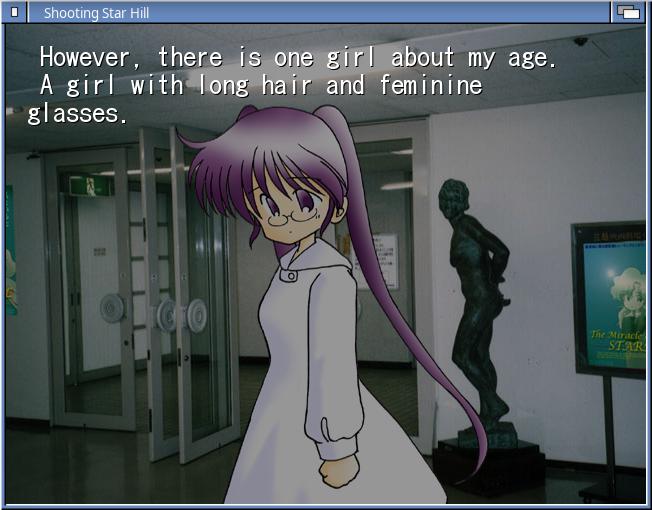
Chihiro discovers that Kana is perceived as odd by the class and, as a result, is always alone. Moreover, she proves to be quite taciturn when he tries to talk to her. None of this deters Chihiro, however, and he works diligently to engage with his new classmate. The story focuses on Chihiro’s efforts to break the ice with his mysterious classmate and their budding relationship.
Shooting Star Hill Review
I will review the different components of Shooting Star Hill in the following sub-sections.
Game-Play of Shooting Star Hill
Shooting Star Hill is relatively short visual novel. Visual Novel Database suggests that it takes about 50 minutes to read. While I am generally a fast reader and did not time myself, somewhere in the 40-60 minute range sounds about right.

In that time, the player is presented with choices on only two occasions. The first choice has no effect on the direction of the game. The second choice determines which of the two endings the player reaches – with one being the game’s good ending and the other being the bad ending.
Structure
Up until the only substantive choice right near the end of the game, Shooting Star Hill is an almost entirely kinetic visual novel – having no choices at all except for one insignificant choice in the middle of the story. The decisive choice at the end provides the game with its one point of meaningful interactivity and its branching path.
For all intents and purposes, and especially in light of the fact that the player can create a save point when he or she is presented with choices, potential readers should think of Shooting Star Hill as a linear visual novel (that is – just about all text and images and no interaction) which happens to present one key choice at its end. Shooting Star Hill provides nine save slots – which is more than anyone should need.
(To use an illustrative example for those of you who are not familiar with visual novels, imagine that you are reading a 100 page book. On page 90, the book suddenly turns into a “choose your own adventure” novel, telling you to either go to page 91 or 96 based on the choice you make. Pages 91-95 represent one end to the story and pages 96-100 represent the other ending.)
Visual Presentation of Shooting Star Hill
Shooting Star Hill mostly uses real photographs for its backgrounds, and the text overlays those backgrounds instead of being limited to a text box. In this way, its presentation is identical to Night of the Forget-Me-Nots, the previous visual novel that I reviewed.
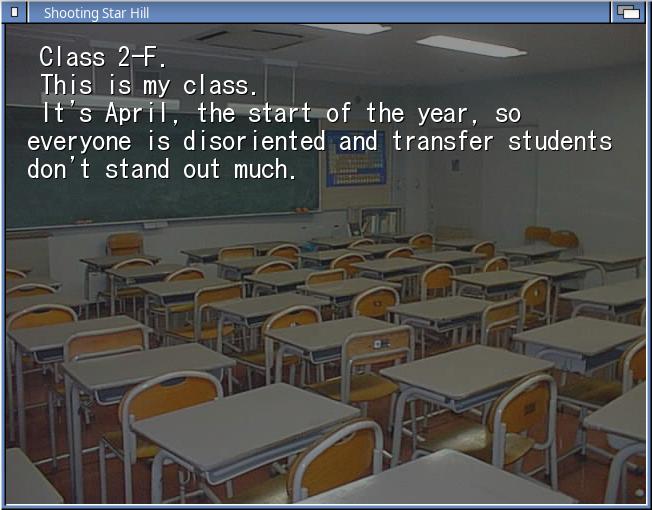
However, unlike Night of the Forget-Me-Nots and my first review for the project, The Poor Little Bird, Shooting Star Hill has character portraits for the five characters who appear in the game in addition to the protagonist, Chihiro Naruse. The portraits have a distinct style – simple textures and colors, big eyes, no noses, and interesting hair colors – all somewhat 90s-esque. See a non-Kana example below below:
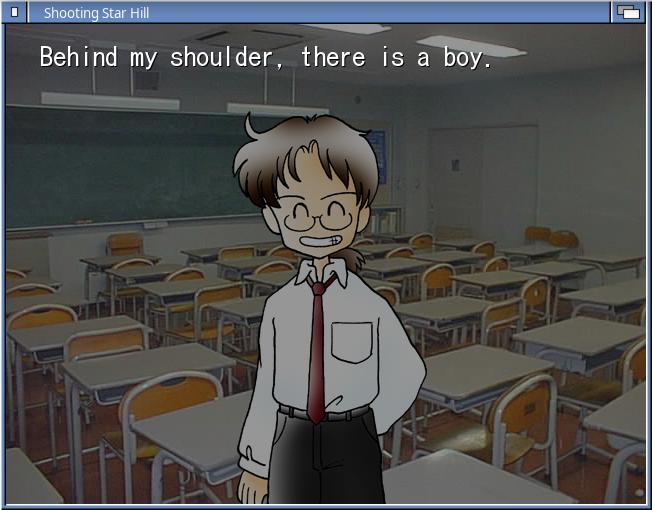
The character portraits are clean, bright, and create an aesthetic for the game. The style may be an acquired taste, but I came away a fan. I also appreciated the attention to detail given to the heroine, Kana Moriyama. She received three in-game outfits and a number of poses to cover a number of scenes and dialogues. The only portrait that I thought missed the mark was that of the protagonist’s little sister and her unnaturally green hair.
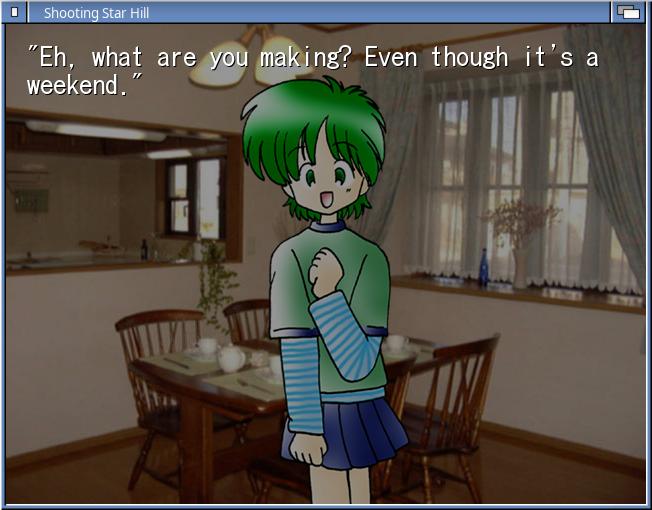
The game had a suitable variety of photographic backgrounds for different locations. The character portraits do not visually blend into the backgrounds, but that had the positive effect of making them pop. I do commend the team for carefully attending to how the portraits were positioned with respect to the backgrounds. One flaw that I noted is that the text sometimes blended a bit into the background. While I never had trouble reading the dialogue – I could see it being an issue for some.
Had Shooting Star Hill stuck to character portraits on top of photographic backgrounds, its visual presentation would have been adequate. However, it went above and beyond by including a significant number of fully hand-drawn scenes – including both a character and a background.
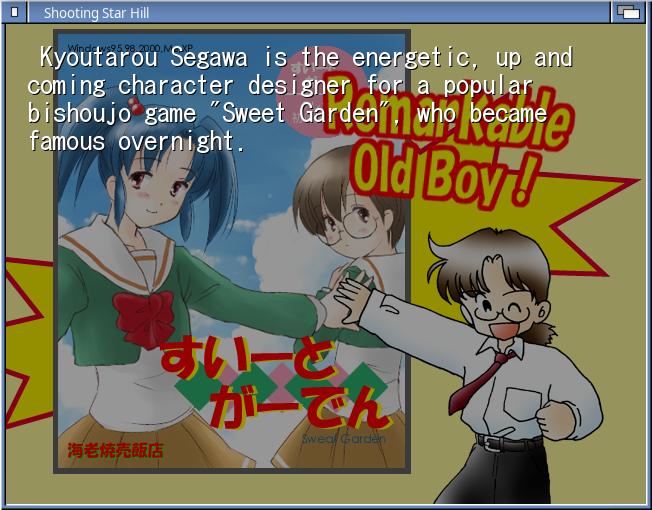
I was genuinely surprised by the scenes – having initially expected the game to be fully composed of photograph backgrounds and character portraits.
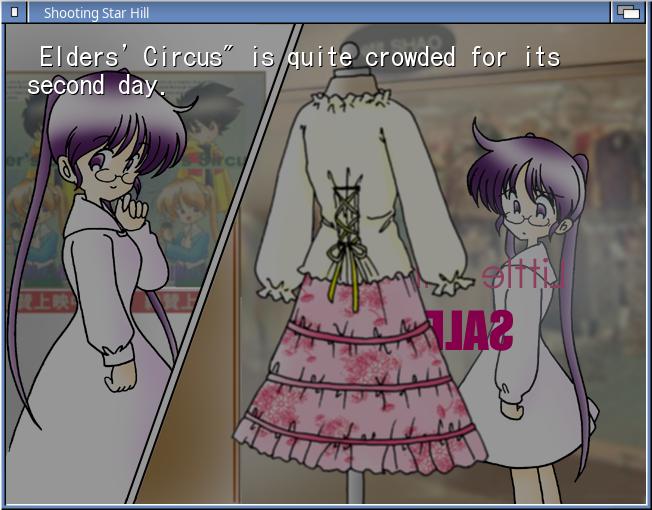
Moreover, I was surprised to see how many fully drawn cards were included in Shooting Star Hill. Each one looked terrific. There were also a few examples of dynamically-changing visuals (see example below):
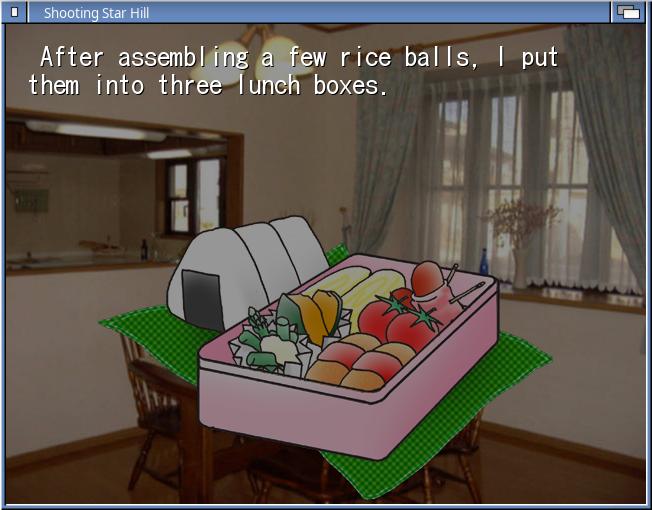
The game also had a few scenes featuring BBS pages – giving the story a nice time-specific touch.
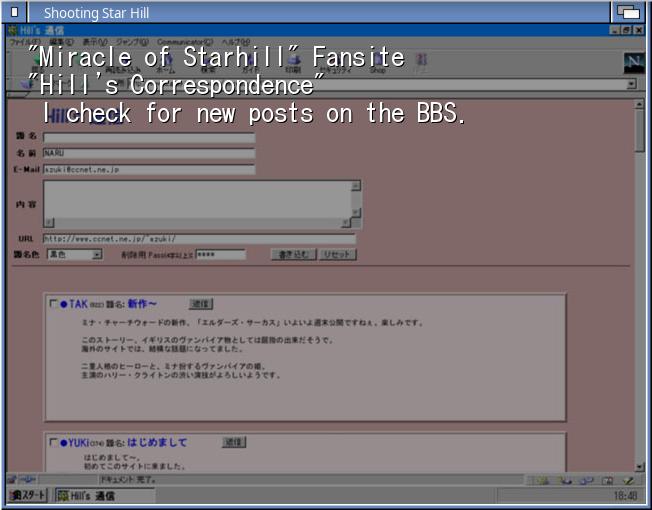
Thanks to the crisp character portraits and the large number of fully-drawn scenes, Shooting Star Hill is one of the most visually interesting Insani/al|together translations.
Music
Shooting Star Hill contained a small number of musical tracks, none of which were particularly memorable save for the song that plays with the end credits for the good ending, which unexpectedly includes very pleasant vocals by Mayusa. The music never grated or felt inappropriate or out-of-place. Here, the music played a background role to the story and terrific visuals of Shooting Star Hill.
Translation Quality
On the festival page for Shooting Star Hill, the translator wrote the following:
Ah, my first visual novel translation. It was quite fun, but also a challenge. I think I learned a lot of kanji while translating this, actually…and having the kanji in digital format makes them easier for digital lookup.
The translator also noted that he received assistance from the game’s author, Mr. Azuki Taka.
I always preface my reviews on writing and translations by noting that I do not know Japanese. Thus, my review of the “translation” is really a review of how the story reads in English – I cannot account for any discrepancies that may exist between the translation and the original. In this case, that the author of the original Japanese text participated in the translation to some extent should lend some confidence that the English version is faithful to the Japanese.
Much like every al|together translation I have read (including some that I have yet to review), Shooting Star Hill reads well in English.
The dialogue came off as natural in English in the main, and it compares favorably to many commercial efforts in that respect. However, one unfortunate point is that the dialogue between Chihiro and Kana felt a bit unduly imprecise in some key moments – meaning that it relied on some broad word choices where more specific ones would have been warranted in context. The specific cases are not amenable to publication in a spoiler-free review, but I do highlight several examples in my companion article. Some of the vagueness – in my view – may derive from compromises made to accommodate the game’s dual-track plot, wherein the sentiments that Kana and Chihiro express deal in one sense with Kana as a normal girl and in another with Kana in a broader context. A particular point that requires careful reading and consideration is Kana’s use of the word “normal” and Chihiro’s responses to her – there are meanings and ideas in their conversations on the subject that are not clearly conveyed by their word choices.
In a technical sense, Shooting Star Hill was easty to read. The only readability issue that I had was that there were a few points in extended dialogues where I momentarily lost track of which character was speaking – something that can happen when dialogue is presented as straight text without noting the speaker of each line. But it was always possible to re-focus and quickly orient myself to the conversation.
Writing Quality and Story
Here, I consider the quality of Shooting Star Hill’s writing as is (that is, the final project – without thinking of it as a translation) and its story quality. I will also strive to avoid spoilers, which somewhat limits how specific I can be in this section.
Shooting Star Hill did well to give the two main characters, Chihiro and Kana, distinct voices and personalities. Watching Chihiro try to break the ice with Kana and their subsequent conversations was consistently charming. The supporting characters were written less distinctly, but they too had their own voices.
Shooting Star Hill has two plots. One covers the discrete interactions of Chihiro and Kana. The other incorporates broader events. The strongest part of Shooting Star Hill is its humane story, which focuses on Chihiro’s efforts to get to know Kana. The overarching story has twists which eventually come to test the growing bond between the protagonists. While Shooting Star Hill does not depict a world where everything is ordinary, its twists are never too surprising. To put it succinctly, Shooting Star Hill always shows its cards in advance, and it always plays the cards that it shows. Its twists are telegraphed in such a way that the player is unlikely to be caught off guard by how events transpire – even if the events are surprising in and of themselves.
While Shooting Star Hill is well-structured in that it sets up its dramatic events in a logical way and largely refrains from introducing elements that it does not use, it leaves much about the overarching plot unexplained in both of its endings. Here, I will not say about what is not explain but will limit myself instead to saying they are related to the aforementioned twists and extraordinary aspects of the story. I did not see Shooting Star Hill’s decision to leave unexplained the technical aspects of how certain things in its world worked as detracting from the story – primarily because I understood the true point of the visual novel be the relationship between the two main characters. The story served to add a dramatic and thematic backdrop to their story.
Notwithstanding that which is left unexplained, Shooting Star Hill’s good ending is cathartic and represents the sort of “new beginning” ending that I covered in From the Bottom of the Heart – and its alternative ending highlights the high stakes involved in Chihiro’s decisions.
Omitting context, I will include a quote from the point-of-view character, Chihiro, that I believe sums up the moral of Shooting Star Hill well:
I think that what’s normal and what’s not normal has no relevance to a person.
At its core, Shooting Star Hill is the story of a lonely girl and the boy who makes a point of seeing her as she is through his own eyes. While this line, like a couple of Chihiro’s other important lines, was slightly awkward – he expresses one of his views that made his relationship with Chihiro possible.
My Overall Review and Recommendations
I was not sure what to expect from Shooting Star Hill going into my play-through. The introduction suggested that it would be a light romantic comedy. To be sure, it was at times, but the story was ultimately heavier than what I expected.
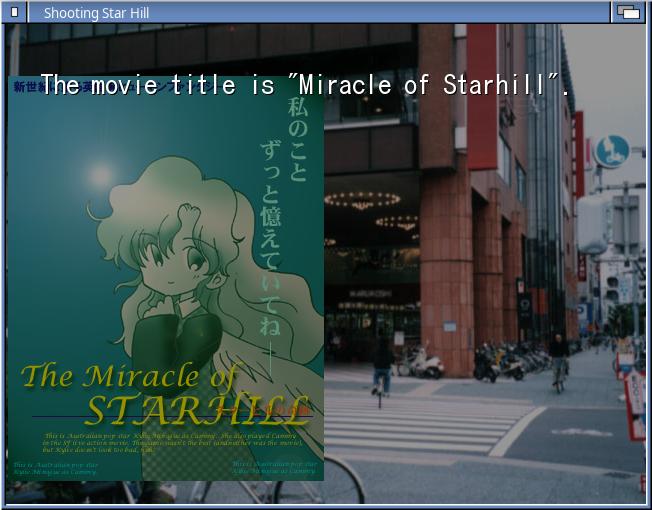
On the whole, I was very impressed with the amount of work that went into the visual presentation – which stands as the game’s most memorable aspect. With respect to the story, I appreciated that Shooting Star Hill did not try to do too much. It is ultimately a surprisingly tightly constructed game – wasting few words and hammering home its central theme: It is alright to not be “normal” – and someone can care for a person who is not “normal” regardless of what anyone else thinks.
Whether Shooting Star Hill’s overarching story was the best way to present its main theme is a debatable. However, in light of the direction the writers took, I appreciated the fact that they opted to telegraph the twists in the story instead of springing them on the reader for shock value. In choosing this path, the team kept my attention on the relationship between Chihiro and Kana and the game’s central point that one of our lead characters was just fine.
While granting some people may have issues with Shooting Star Hill’s overarching plot, I give it my unqualified recommendation. It is not only one of the best visual novels to come out of the al|together festival, but a very good visual novel without considering that it was a small indie effort. It presents Kana’s story of loneliness and isolation in a very humane way. While Kana is the star of the story, Chihiro, the view-point character, is a surprisingly strong view-point character thanks to his efforts to genuinely understand Kana and how she sees the world. In my analysis piece, I explain in some detail how Shooting Star Hill’s overarching plot can (and in my view, should) be understood as providing metaphors for Kana’s distinctly human loneliness.
The Readme file includes the following statement:
If at all possible, although there are some awkward points, it would make me happy if you enjoy it.
Shooting Star Hill is a little rough around the edges, but it is, on the whole, a very good piece, and one which I much enjoyed and recommend.
Follow-Up Post
For those who are interested, you can read my spoiler-filled analysis of the story of Shooting Star Hill in my follow-up article.